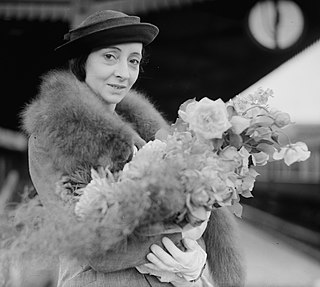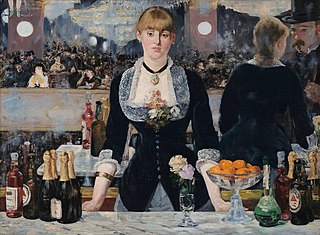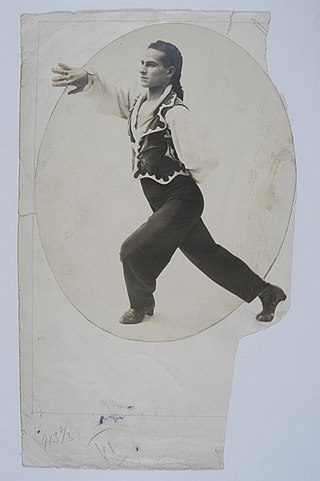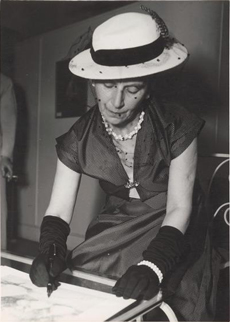
Vaslav or Vatslav Nijinsky was a Russian ballet dancer and choreographer of Polish ancestry. He is regarded as the greatest male dancer of the early 20th century.
The Cecchetti method is variously defined as a style of ballet and as a ballet training method devised by the Italian ballet master Enrico Cecchetti (1850–1928). The training method seeks to develop essential skills in dancers as well as strength and elasticity. Cecchetti-trained dancers are commonly found in ballet and other dance companies throughout the world.

Bronislava Nijinska was a Russian ballet dancer of Polish origin, and an innovative choreographer. She came of age in a family of traveling, professional dancers.

The Afternoon of a Faun is a ballet choreographed by Vaslav Nijinsky for the Ballets Russes, and was first performed in the Théâtre du Châtelet in Paris on 29 May 1912. Nijinsky danced the main part himself. The ballet is set to Claude Debussy's symphonic poem Prélude à l'après-midi d'un faune. Both the music and the ballet were inspired by the poem L'Après-midi d'un faune by Stéphane Mallarmé. The costumes, sets and programme illustrations were designed by the painter Léon Bakst.
Maude Lloyd was a South African ballet dancer and teacher who immigrated to England and became an important figure in early British ballet as a founding member of Ballet Rambert. She had a significant second career as a dance critic, writing with her husband under the nom de plume Alexander Bland.

Dame Alicia Markova DBE was a British ballerina and a choreographer, director and teacher of classical ballet. Most noted for her career with Sergei Diaghilev's Ballets Russes and touring internationally, she was widely considered to be one of the greatest classical ballet dancers of the twentieth century. She was the first British dancer to become the principal dancer of a ballet company and, with Dame Margot Fonteyn, is one of only two English dancers to be recognised as a prima ballerina assoluta. Markova was a founder dancer of the Rambert Dance Company, The Royal Ballet and American Ballet Theatre, and was co-founder and director of the English National Ballet.

The Ballets Russes was an itinerant ballet company begun in Paris that performed between 1909 and 1929 throughout Europe and on tours to North and South America. The company never performed in Russia, where the Revolution disrupted society. After its initial Paris season, the company had no formal ties there.

Lydia Sokolova (1896–1974) was an English ballerina. She trained at the Stedman Ballet Academy and learned from accomplished dancers including Anna Pavlova and Enrico Cecchetti, and was a prominent member of Sergei Diaghilev's Ballets Russes from 1913 to 1929. After the disbandment of that company, she taught, choreographed and occasionally danced. Her last stage performances were in 1962 at the Royal Opera House, London.

Olga Alexandrovna Spessivtseva was a Russian ballerina whose stage career spanned from 1913 to 1939.
The Original Ballet Russe was a ballet company established in 1931 by René Blum and Colonel Wassily de Basil as a successor to the Ballets Russes, founded in 1909 by Sergei Diaghilev. The company assumed the new name Original Ballet Russe after a split between de Basil and Blum. De Basil led the renamed company, while Blum and others founded a new company under the name Ballet Russe de Monte-Carlo. It was a large scale professional ballet company which toured extensively in Europe, Australia and New Zealand, the United States, and Central and South America. It closed down operations in 1947.

Ashley Dukes was an English playwright, critic and theatre manager. He was the husband of ballet dancer Dame Marie Rambert.
British ballet is most recognised for two leading methods, those of the Royal Ballet School and the Royal Academy of Dance. The identifying characteristic of British ballet is the focus on clean, precise technique and purity of line that is free of exaggeration and mannerisms. The training of dancers in Britain is noted for its slow progression, with a great deal of attention paid to basic technique. British ballet methods operate on the principle that establishing correct technique and strength slowly makes it much easier for the student to adapt to more difficult vocabulary and techniques later on. The main difference between the two is that The Royal Ballet School trains professional dancers, the Royal Academy of Dance trains teachers.
Rambert is a leading British dance company. Formed at the start of the 20th century as a classical ballet company, it exerted a great deal of influence on the development of dance in the United Kingdom, and today, as a contemporary dance company, continues to be one of the world's most renowned dance companies. It has previously been known as the Ballet Club, and the Ballet Rambert.

Bar aux Folies-Bergère is a one-act ballet created in 1934 with the scenario and choreography by Ninette de Valois. The music consists of piano works of Emmanuel Chabrier selected and arranged by Constant Lambert, and the designs were by William Chappell after Manet.

Mona Inglesby , was a British ballet dancer, choreographer, director of the touring company International Ballet, and the person who saved the Sergeyev Collection for posterity.
Stanislas Idzikowski was a Polish dancer and ballet master, active in England, and with such historic companies as Pavlova's, Ballets Russes, and Vic-Wells. During his performance career, 1910-1933, he became famous for his brilliant classical technique, and for the development of ballet roles. With Beaumont he co-authored an influential book on the Cecchetti Method, still in print. He later taught dance in London.
Kyra Vaslavovna Nijinsky, was a ballet dancer of Polish and Hungarian ancestry, with a Russian dance and cultural heritage. She was the daughter of Vaslav Nijinsky and the niece of Bronislava Nijinska. In the 1930s she appeared in ballets mounted by Ida Rubinstein, Max Reinhardt, Marie Rambert, Frederick Ashton, Antony Tudor.

Nina Semyonovna Youshkevitch was a Franco-Russian ballet dancer and teacher. After a notable dancing career an injury forced her retirement, and she became a prominent ballet teacher and choreographer.

Leon Woizikovsky, originally Léon Wójcikowski was a Polish dancer and ballet master, and later choreographer and teacher. He first came to prominence as a member of the Ballets Russes. Later he worked with various ballet companies, e.g., Pavlova, de Basil, de Valois, Ballet Polonaise, Massine, the London Festival, the Royal Flemish.
Five Brahms Waltzes in the Manner of Isadora Duncan is a ballet solo choreographed by Frederick Ashton to music by Johannes Brahms, inspired by Isadora Duncan and created for Lynn Seymour. The first version, under the title Brahms Waltz, used only Brahms' Op. 39, No. 15, and premiered on 22 June 1975, at the Hamburg State Opera. The expanded version, which featured more Brahms waltzes, premiered on 15 June 1976, during Ballet Rambert's 50th anniversary gala, at the Sadler's Wells Theatre, London, and is dedicated to Marie Rambert.













